
Scilla autumnalis L.
Fam. : Hyacinthaceae
© Pascale SERVAIS & Pierre SEBA, 2018. Tilo Botanica: Flore de Tilos et du Dodécanèse / Flora of Tilos and of the Dodecanese
English translation by Brenda Bradbury, Howard Bradbury and Stéphane Léonard
Plante herbacée, hermaphrodite, érigée, à bulbe ovoïde, lisse, blanchâtre, de 15 mm de diamètre, à hampe florale non feuillée, glabre.
Feuilles à la base, simples, linéaires, filiformes, de 0,5 à 3 mm de large, de 15 cm de long au plus, en gouttière, glabres, commençant à pousser à la floraison.
Fleurs à symétrie radiaire, mauves, lilas, bleues ou pourpre rosâtre, d’abord en cloche puis étoilées, de 5 à 10 mm de diamètre, réunies par 6 à 20 en grappes de 15 à 50 mm de long. Pédicelles dressés, 1 à 2 fois plus longs que la fleur, sans bractée à leur base. Périanthe à 6 tépales libres (3 sépales et 3 pétales identiques), tachés de pourpre au revers. 6 étamines à filet mauve et anthère noire. 1 style mauve. Ovaire supère.
Fruits, capsules arrondies, petites, à 3 loges contenant chacune 2 graines noires.
___________________________
Plant herbaceous, hermaphrodite, erect. Bulb ovoid, smooth, whitish, 15 mm in diameter. Floral pole nonleafy, glabrous.
Leaves at the base, simple, linear, thread-like, from 0.5 to 3 mm across, 15 cm long at most, in gutter, glabrous, starting to grow at flowering.
Flowers radially symmetrical, mauve, lilac, blue or pinkish purple, initially bell-shaped then stellate, from 5 to 10 mm in diameter, joined together by 6 to 20 in racemes from 15 to 50 mm long. Pedicels erect, 1 to 2 times longer than the flower, without a bract at their base. Perianth with 6 free tepals (3 sepals and 3 identical petals), speckled purple on the reverse. 6 stamens with a mauve filament and a black anther. 1 style purple. Ovary superior.
Fruits, rounded, small capsules with 3 loculi each one containing 2 black seeds.
Descripteurs / Identifying features
1
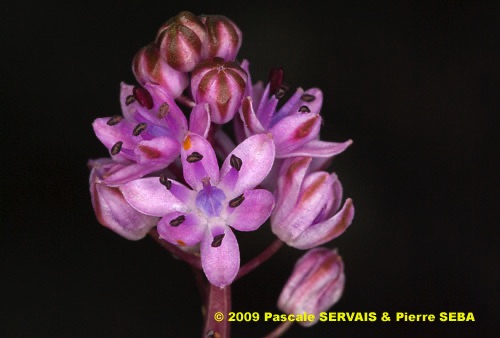
2
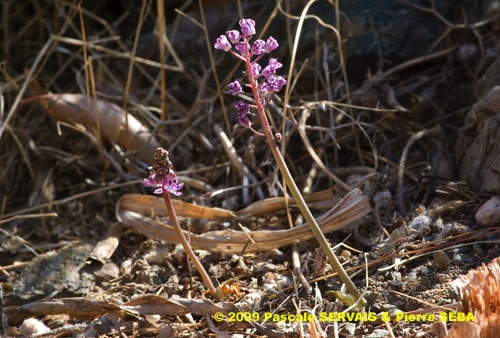
3
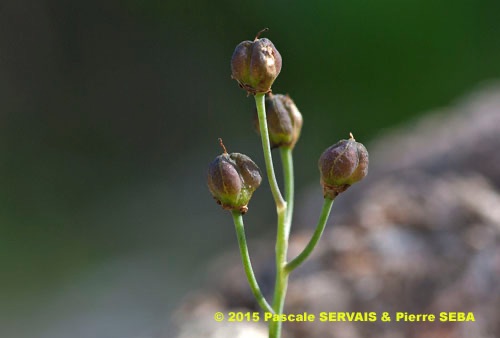
4
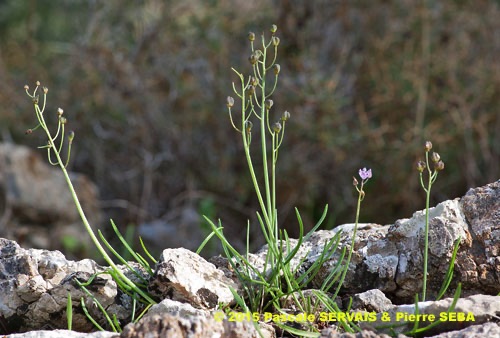
5
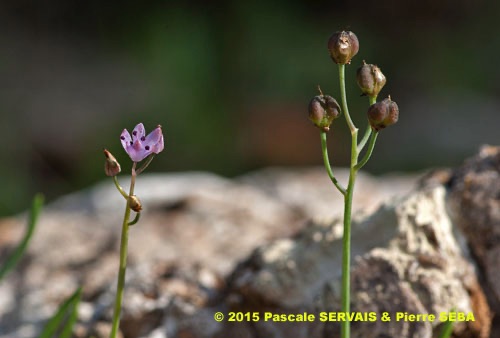
6
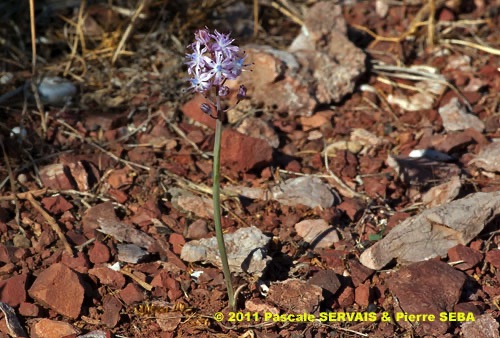
7
Étymologie / Etymology :
Scilla : emprunt du latin scilla, -ae (nom) = la scille, nom donné à l’oignon
marin (drimia maritima) par Pline, naturaliste latin mort en 79 apr. J.-C.,
forme latinisée du grec ancien σκίλλα, -ης (nom) = la scille, nom
donné à l’oignon marin (drimia maritima) par Théophraste, philosophe
péripatéticien, disciple d’Aristote, botaniste et naturaliste, mort
vers 288 av. J.-C.
Autumnalis : emprunt du latin autumnalis, -is, -e (adj.)
[ < autumnus, -i (nom) = l’automne ] = d’automne, qui pousse en
automne, en référence à sa période de floraison.
Scilla : borrowed from scilla, -ae (noun) = squill, name given to the
marine onion (drimia maritima) by Plinius, Latin naturalist died
in 79 AD, Latinized form of the Classical Greek σκίλλα, -ης (noun)
= squill, name given to the marine onion (drimia maritima) by
Theophrastus, peripatetic philosopher, disciple of Aristotle, botanist
and naturalist, died towards 288 BC.
Autumnalis : borrowed from Latin autumnalis, -is, -e (adj)
[ < autumnus, -i (noun) = autumn ] = autumnal, which grows in
autumn, referring to its flowering time.
Synonymes / Synonyms :
Prospero autumnale (L.) Speta
Anthericum autumnale (L.) Scop.
Genlisa autumnalis (L.) Raf.
Hyacinthus autumnalis (L.) E.H.L.Krause
Ornithogalum autumnale (L.) Lam.
Prospero autumnale var. autumnale
Scilla autumnalis var. autumnalis
Scilla dumetorum Balansa ex Baker
Scilla gallica Tod.
Scilla holzmannia Heldr.
Stellaris autumnalis (L.) Bubani
Noms vernaculaires / Common names :
Nom français / French name :
Scille d’automne.
Noms grecs / Greek names :
Μερενδέρα αττικής — Σκύλα η φθινοπωρινή.
Noms anglais / English names :
Autumn squill — Starry hyacinth.
Noms allemands / German names :
Herbst-Blaustern — Herbst-Meerzwiebel — Herbst-Sternhyazinthe.
Noms espagnols / Spanish names :
Jacinto de Otoño — Jacinto endeble.
Nom italien / Italian name :
Scilla autunnale.
Habitat :
Lieux pierreux - Chemins.
Stony places - Waysides.
Île / Island :
Tilos.
Hauteur / Height range :
De 5 cm à 20 cm.
From 5 cm to 20 cm.
Floraison / Flowering time :
De septembre à novembre.
From September to November.
Groupe / Classification :
Monocotylédones.
Monocotyledons.
Pérennité / Lifespan :
Vivace.
Perennial.
Description :
Photo 1 :
Localisation / Location : Tilos, Livadia, Gorges de Lethra
Date : 22/10/2009
GPS : Lat. 36,42943° N / Long. 27,37988° E / Alt. 121 m
Type : Photographie numérique / Digital Photograph (10 mégapixels)
Photo 2 :
Localisation / Location : Tilos, Livadia, Village
Date : 27/10/2009
GPS : Lat. 36,41073° N / Long. 27,38768° E / Alt. 17 m
Type : Photographie numérique / Digital Photograph (10 mégapixels)
Photo 3 :
Localisation / Location : Tilos, Livadia, Gorges de Lethra
Date : 22/10/2009
GPS : Lat. 36,42943° N / Long. 27,37988° E / Alt. 121 m
Type : Photographie numérique / Digital Photograph (10 mégapixels)
Photo 4 :
Localisation / Location : Tilos, Livadia, Village
Date : 17/11/2014
GPS : Lat. 36,41073° N / Long. 27,38768° E / Alt. 17 m
Type : Photographie numérique / Digital Photograph (10 mégapixels)
Photo 5 :
Localisation / Location : Tilos, Livadia, Village
Date : 17/11/2014
GPS : Lat. 36,41073° N / Long. 27,38768° E / Alt. 17 m
Type : Photographie numérique / Digital Photograph (10 mégapixels)
Photo 6 :
Localisation / Location : Tilos, Livadia, Village
Date : 17/11/2014
GPS : Lat. 36,41073° N / Long. 27,38768° E / Alt. 17 m
Type : Photographie numérique / Digital Photograph (10 mégapixels)
Photo 7 :
Localisation / Location : Tilos, Livadia, Pano Meri
Date : 01/10/2011
GPS : Lat. 36,39840° N / Long. 27,39462° E / Alt. 148 m
Type : Photographie numérique / Digital Photograph (10 mégapixels)

Clés dichotomiques et descripteurs distinctifs des 2 espèces / Dichotomous keys and distinctive identifying features of the 2 species
Google Maps
Google Maps
Google Maps
Google Maps
Google Maps
Google Maps
Google Maps